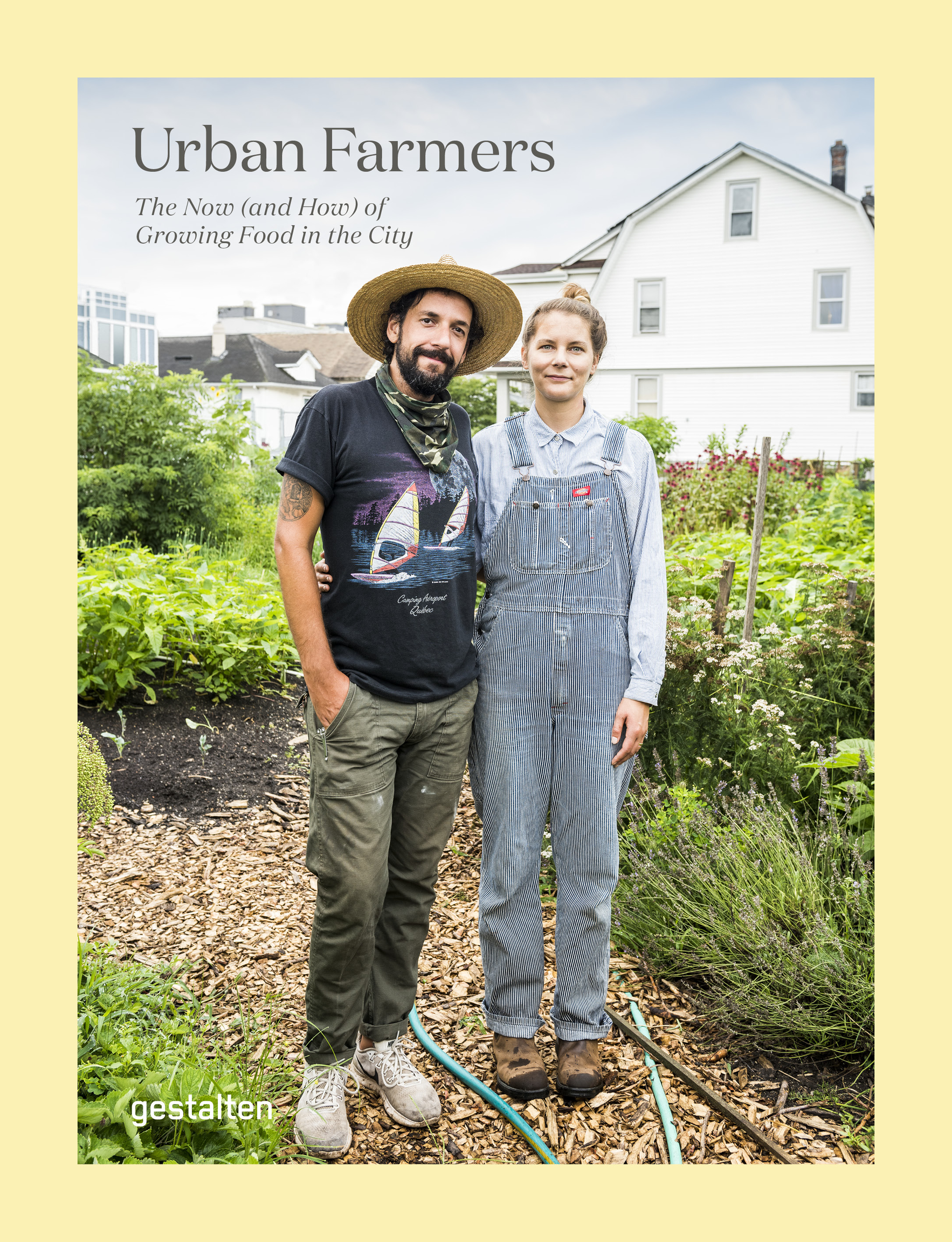Secondary tabs
Urban Farmers
The Now (and How) of Growing Food in the City
Editors: gestalten & Valery Rizzo
Texts by Mónica R. Goya
Features: Full color, hardcover, stitch bound, 256 pages
Format: 18 × 23 , 5 cm, 7 × 9 ¼ inches
Price: €35 (D) £ 30 $ 50 (US)
ISBN: 978-3-96704-006-7
@gestalten @valrizzo @monicargoya #urbanfarmersbook
EU+ UK Publication Date: April 29, 2021
INT Publication Date: July 13, 2021
ABOUT THE BOOK
The concrete jungles of modern cities might seem hostile to nature, but they are full of natural life. From beekeeping on rooftops to underground mushroom farms, Urban Farmers explores the rich world of planting, growing, and harvesting in modern cities and shows that soil, seeds, and concrete can be the unexpected formula for a greener, healthier and more sustainable life in the city.
There are as many reasons to start growing food as there are urban farmers. This book showcases the vast universe of urban agriculture in different parts of the world, revealing what makes each of the farms and projects featured unique. Some run their projects as innovative, for-profit start-ups, while others pursue a nonprofit approach based on alleviating systemic structural issues affecting their communities. Presenting a mix of in-depth case studies, inspiring profiles of the movement’s pioneers and essays by experts in the field, Urban Farmers gives its readers the opportunity to learn from the best and get their hands dirty—be it on a balcony, in a community garden, or even by growing a business in the very heart of the metropolis.
In the early days of the Covid-19 pandemic, empty supermarket shelves revealed the fragility of current food systems. The disarray of the global food supply chain might have fueled the revived push for locally produced foods: A considerable number of urban farms offering CSA programs, which provide households with a box of locally grown fruit and vegetables, have reported increases in demand that tripled or quadrupled their pre-Covid-19 numbers. And while it’s true that urban development has wiped out most signs of agrarian legacy in cities across the world, today there are more options than ever before to grow food in urban settings. Urban farmers have a unique opportunity to touch on many disciplines at once and become dynamic forces of positive change in their communities.
At the same time, over 23.5 million U. S. citizens live in food deserts—defined as areas lacking access to good-quality, healthy, fresh food—an echo of the systemic racism infused in the country’s food system. Leah Penniman, founding co-director of Soul Fire Farm in New York, considers the situation food apartheid, a term coined by activist Karen Washington. “It’s not a natural desert, it’s a human-created system of segregation,” she says.
There are programs addressing vital food sovereignty issues affecting underserved communities and providing families with the tools and guidance to grow their own produce, which has been especially meaningful during the pandemic. These social aspects of urban farming are of great importance, but promoting biodiversity by serving as habitats for plants and animals is also crucial. According to the Food and Agriculture Organization of the UN, vegetable crops worldwide lost 75 percent of their genetic diversity between 1900 and 2000. “We seem to be facing so many different types of emergency: climate, humanitarian, biodiversity, health” Australian gardener Kat Lavers says. “Cities are never going to be self-sufficient, but they can have more of a buffer. So, by growing food at home, we can contribute to the solution; we can make things a bit more resilient, more comfortable when we get challenged by these sorts of events.” We need an “ecolution,” Ron Finley, guerilla gardener from L.A., agrees—an ecological revolution for the planet—and he hopes that the pandemic will shift our values system:
“We don’t think about how the food gets to the store, if the people who harvested it can afford it, or how many hours of backbreaking work in the field they go through to grow a beautiful lettuce. We don’t see the value in soil that we should see. That’s how we change that mindset—seeing the power in the freedom that is in soil. If you are growing your own food, you are free from an oppressive society, from an unjust food system.” Ron Finley, self-defined “gangsta gardener”, urban anthropologist and activist form Los Angeles
From a rooftop farm in the Indonesian island of Java that aims to sell produce at affordable prices and provide more opportunities for women without access to higher education to a passionate activist tackling food insecurity by teaching urban farming skills in Nairobi; from closing the circle between fertilization and composting as well as cultivating culturally significant seeds that can help to bridge communities and cultures through food—Urban Farmers is an invitation to roll up the sleeves, start digging and ultimately grow not only vegetables but strong communities.
ABOUT THE CO-EDITOR AND WRITER
Valery Rizzo is an American portrait, food, and lifestyle photographer focused on urban life and agriculture. She lives in Park Slope and can often be found photographing urban farms, local producers, restaurants and the streets of Brooklyn. Her work has appeared in The New York Times Style Magazine, Yes! Magazine, Bon Appétit, D La Repubblica and Der Spiegel among other publications.
Mónica R. Goya is a journalist and photographer based in London. Her work focuses primarily on the fields of farming, food, environmental issues and travel and appears in The New York Times, Condé Nast Traveler and Saveur among others. Her long-term journalistic projects explore the culture of working the land and the intersection of human rights, food politics and sustainability.
Please note: The cover should be credited in the following format »Photo Valery Rizzo, Urban Farmers, gestalten 2021«, the spreads should be credited with »Urban Farmers, gestalten 2021« – thank you.
Embargo:
Please ask for permission first if you would like to review the book before the official publication date.














